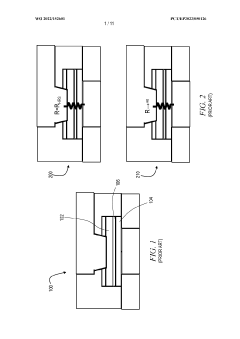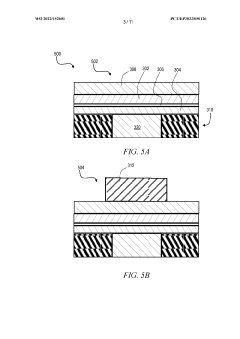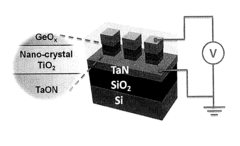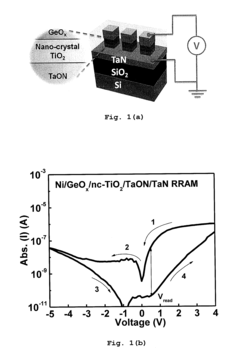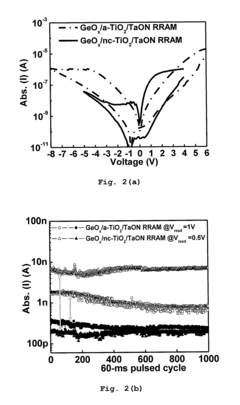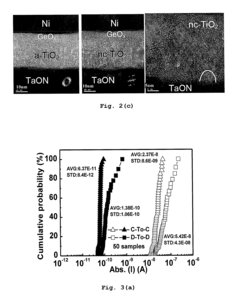Benchmark RRAM Functionality in AI-driven Analytics
SEP 10, 202510 MIN READ
Generate Your Research Report Instantly with AI Agent
Patsnap Eureka helps you evaluate technical feasibility & market potential.
RRAM Technology Evolution and Objectives
Resistive Random-Access Memory (RRAM) has emerged as a promising technology in the landscape of non-volatile memory solutions over the past two decades. Initially conceptualized in the early 2000s, RRAM has evolved from a theoretical construct to a commercially viable technology with significant potential for AI-driven analytics applications. The fundamental principle of RRAM relies on the resistance switching phenomenon in dielectric materials, allowing for binary or multi-level data storage through controlled formation and rupture of conductive filaments.
The evolution of RRAM technology has been marked by several significant milestones. Early research focused primarily on material exploration and understanding the underlying physical mechanisms. By the mid-2010s, the focus shifted toward device optimization, addressing challenges related to endurance, retention, and switching uniformity. Recent developments have concentrated on scaling capabilities, 3D integration, and compatibility with conventional CMOS processes, enabling higher density memory arrays suitable for data-intensive AI applications.
Current technological objectives for RRAM in AI-driven analytics center around enhancing performance metrics critical for neural network operations. These include improving write/read speeds to sub-nanosecond levels, reducing power consumption to enable edge AI implementations, and increasing memory density to accommodate growing model sizes. Additionally, there is significant interest in leveraging the inherent analog nature of RRAM for in-memory computing paradigms, which could dramatically accelerate matrix operations fundamental to AI workloads.
The convergence of RRAM technology with AI analytics presents unique opportunities and challenges. On one hand, RRAM's non-volatile nature, high density, and potential for analog computation align perfectly with the requirements of modern AI systems. On the other hand, issues related to device variability, endurance limitations, and yield rates continue to pose significant hurdles for widespread adoption in commercial AI applications.
Benchmarking RRAM functionality specifically for AI-driven analytics requires establishing standardized evaluation frameworks that go beyond traditional memory metrics. These frameworks must incorporate parameters relevant to neural network performance, such as weight precision requirements, update frequency, and energy efficiency during inference and training operations. The development of such benchmarking methodologies represents a critical step toward quantifying the potential benefits of RRAM technology in accelerating AI workloads.
Looking forward, the technological roadmap for RRAM in AI applications aims to achieve seamless integration with neuromorphic computing architectures, enabling more efficient implementation of spiking neural networks and other brain-inspired computing paradigms. This integration could potentially lead to AI systems with significantly reduced energy footprints and enhanced real-time processing capabilities, particularly for edge computing applications where power constraints are paramount.
The evolution of RRAM technology has been marked by several significant milestones. Early research focused primarily on material exploration and understanding the underlying physical mechanisms. By the mid-2010s, the focus shifted toward device optimization, addressing challenges related to endurance, retention, and switching uniformity. Recent developments have concentrated on scaling capabilities, 3D integration, and compatibility with conventional CMOS processes, enabling higher density memory arrays suitable for data-intensive AI applications.
Current technological objectives for RRAM in AI-driven analytics center around enhancing performance metrics critical for neural network operations. These include improving write/read speeds to sub-nanosecond levels, reducing power consumption to enable edge AI implementations, and increasing memory density to accommodate growing model sizes. Additionally, there is significant interest in leveraging the inherent analog nature of RRAM for in-memory computing paradigms, which could dramatically accelerate matrix operations fundamental to AI workloads.
The convergence of RRAM technology with AI analytics presents unique opportunities and challenges. On one hand, RRAM's non-volatile nature, high density, and potential for analog computation align perfectly with the requirements of modern AI systems. On the other hand, issues related to device variability, endurance limitations, and yield rates continue to pose significant hurdles for widespread adoption in commercial AI applications.
Benchmarking RRAM functionality specifically for AI-driven analytics requires establishing standardized evaluation frameworks that go beyond traditional memory metrics. These frameworks must incorporate parameters relevant to neural network performance, such as weight precision requirements, update frequency, and energy efficiency during inference and training operations. The development of such benchmarking methodologies represents a critical step toward quantifying the potential benefits of RRAM technology in accelerating AI workloads.
Looking forward, the technological roadmap for RRAM in AI applications aims to achieve seamless integration with neuromorphic computing architectures, enabling more efficient implementation of spiking neural networks and other brain-inspired computing paradigms. This integration could potentially lead to AI systems with significantly reduced energy footprints and enhanced real-time processing capabilities, particularly for edge computing applications where power constraints are paramount.
Market Analysis for AI-driven RRAM Applications
The global market for RRAM (Resistive Random Access Memory) in AI applications is experiencing significant growth, driven by increasing demands for efficient, high-performance computing solutions in data-intensive AI workloads. Current market valuations place the AI-specific RRAM sector at approximately $1.2 billion, with projections indicating a compound annual growth rate of 27% through 2028.
The demand for RRAM technology in AI applications stems primarily from its unique value proposition: lower power consumption, higher density, and non-volatile characteristics compared to traditional memory solutions. These attributes make RRAM particularly attractive for edge AI applications where power efficiency is paramount. Market research indicates that edge AI implementations utilizing RRAM can achieve up to 60% reduction in power consumption compared to conventional DRAM-based solutions.
Geographically, North America currently leads the market with approximately 42% share, followed by Asia-Pacific at 38% and Europe at 15%. However, the Asia-Pacific region is expected to demonstrate the fastest growth rate, driven by substantial investments in semiconductor manufacturing and AI research in countries like China, South Korea, and Taiwan.
By application segment, the market divides into three primary categories: cloud-based AI infrastructure (48%), edge computing devices (37%), and specialized AI accelerators (15%). The edge computing segment is projected to grow most rapidly as IoT deployments expand and demand for real-time AI processing increases across industrial, automotive, and consumer electronics sectors.
Key customer segments include cloud service providers seeking energy-efficient data center solutions, autonomous vehicle manufacturers requiring low-latency memory for real-time decision making, and consumer electronics companies integrating AI capabilities into resource-constrained devices. Survey data indicates that 73% of enterprise AI decision-makers consider memory performance a critical bottleneck in their current AI implementations.
The economic value proposition of RRAM in AI applications centers on performance-per-watt metrics, with benchmark studies demonstrating 3-5x improvements in inference tasks compared to traditional memory architectures. This translates to substantial operational cost savings in large-scale deployments, with some hyperscale data centers reporting 22-30% reduction in total cost of ownership after implementing RRAM-based AI acceleration solutions.
Market adoption faces challenges including manufacturing scalability issues, integration complexities with existing AI frameworks, and competition from alternative emerging memory technologies like MRAM and PCM. However, recent technological breakthroughs in RRAM fabrication processes have significantly improved yield rates and reliability metrics, addressing key barriers to widespread commercial adoption.
The demand for RRAM technology in AI applications stems primarily from its unique value proposition: lower power consumption, higher density, and non-volatile characteristics compared to traditional memory solutions. These attributes make RRAM particularly attractive for edge AI applications where power efficiency is paramount. Market research indicates that edge AI implementations utilizing RRAM can achieve up to 60% reduction in power consumption compared to conventional DRAM-based solutions.
Geographically, North America currently leads the market with approximately 42% share, followed by Asia-Pacific at 38% and Europe at 15%. However, the Asia-Pacific region is expected to demonstrate the fastest growth rate, driven by substantial investments in semiconductor manufacturing and AI research in countries like China, South Korea, and Taiwan.
By application segment, the market divides into three primary categories: cloud-based AI infrastructure (48%), edge computing devices (37%), and specialized AI accelerators (15%). The edge computing segment is projected to grow most rapidly as IoT deployments expand and demand for real-time AI processing increases across industrial, automotive, and consumer electronics sectors.
Key customer segments include cloud service providers seeking energy-efficient data center solutions, autonomous vehicle manufacturers requiring low-latency memory for real-time decision making, and consumer electronics companies integrating AI capabilities into resource-constrained devices. Survey data indicates that 73% of enterprise AI decision-makers consider memory performance a critical bottleneck in their current AI implementations.
The economic value proposition of RRAM in AI applications centers on performance-per-watt metrics, with benchmark studies demonstrating 3-5x improvements in inference tasks compared to traditional memory architectures. This translates to substantial operational cost savings in large-scale deployments, with some hyperscale data centers reporting 22-30% reduction in total cost of ownership after implementing RRAM-based AI acceleration solutions.
Market adoption faces challenges including manufacturing scalability issues, integration complexities with existing AI frameworks, and competition from alternative emerging memory technologies like MRAM and PCM. However, recent technological breakthroughs in RRAM fabrication processes have significantly improved yield rates and reliability metrics, addressing key barriers to widespread commercial adoption.
RRAM Technical Challenges and Global Development Status
Resistive Random-Access Memory (RRAM) technology faces several significant technical challenges that have impeded its widespread commercial adoption despite its promising characteristics. The primary challenge lies in the device's reliability and endurance. Current RRAM cells typically demonstrate endurance levels of 10^6 to 10^9 write cycles, which falls short of the requirements for high-performance computing applications that demand 10^12 to 10^15 cycles. Additionally, retention time remains problematic, with data degradation occurring over time due to atomic migration within the resistive switching material.
Variability between devices presents another major hurdle. The stochastic nature of filament formation in RRAM cells leads to inconsistent switching behavior across different cells and even within the same cell over multiple programming cycles. This variability complicates the design of reliable read and write circuits, particularly for multi-level cell implementations crucial for AI applications.
Power consumption during the SET operation remains relatively high compared to other emerging memory technologies. The high current densities required for filament formation can lead to thermal issues and energy inefficiency, limiting RRAM's applicability in power-constrained environments such as edge AI devices.
From a global development perspective, RRAM research and commercialization efforts are concentrated in several key regions. The United States leads in fundamental research through institutions like Stanford University, MIT, and companies such as Crossbar Inc. and Intel. Asia, particularly Taiwan, South Korea, and China, dominates in manufacturing integration, with TSMC, Samsung, and SMIC actively developing RRAM technologies for production. European research centers, including IMEC in Belgium and CEA-Leti in France, focus on materials science innovations for RRAM.
Japan maintains a strong position in specialized RRAM applications, with companies like Panasonic and Fujitsu developing solutions for specific industrial applications. Recent collaborations between academic institutions and industry players have accelerated development, with notable partnerships forming international consortia to address key technical challenges.
The technology readiness level (TRL) of RRAM varies significantly by application domain. For simple storage applications, RRAM has reached TRL 7-8 with limited commercial products available. However, for AI-specific implementations requiring complex multi-level cell operations and tight integration with neural network accelerators, the technology remains at TRL 4-5, with functional prototypes demonstrating proof-of-concept but requiring significant refinement before commercial viability.
Recent breakthroughs in material science, particularly the development of novel switching materials like hafnium oxide doped with silicon, have shown promise in addressing reliability issues while maintaining CMOS compatibility. These advancements suggest a potential acceleration in RRAM development for AI applications in the coming years.
Variability between devices presents another major hurdle. The stochastic nature of filament formation in RRAM cells leads to inconsistent switching behavior across different cells and even within the same cell over multiple programming cycles. This variability complicates the design of reliable read and write circuits, particularly for multi-level cell implementations crucial for AI applications.
Power consumption during the SET operation remains relatively high compared to other emerging memory technologies. The high current densities required for filament formation can lead to thermal issues and energy inefficiency, limiting RRAM's applicability in power-constrained environments such as edge AI devices.
From a global development perspective, RRAM research and commercialization efforts are concentrated in several key regions. The United States leads in fundamental research through institutions like Stanford University, MIT, and companies such as Crossbar Inc. and Intel. Asia, particularly Taiwan, South Korea, and China, dominates in manufacturing integration, with TSMC, Samsung, and SMIC actively developing RRAM technologies for production. European research centers, including IMEC in Belgium and CEA-Leti in France, focus on materials science innovations for RRAM.
Japan maintains a strong position in specialized RRAM applications, with companies like Panasonic and Fujitsu developing solutions for specific industrial applications. Recent collaborations between academic institutions and industry players have accelerated development, with notable partnerships forming international consortia to address key technical challenges.
The technology readiness level (TRL) of RRAM varies significantly by application domain. For simple storage applications, RRAM has reached TRL 7-8 with limited commercial products available. However, for AI-specific implementations requiring complex multi-level cell operations and tight integration with neural network accelerators, the technology remains at TRL 4-5, with functional prototypes demonstrating proof-of-concept but requiring significant refinement before commercial viability.
Recent breakthroughs in material science, particularly the development of novel switching materials like hafnium oxide doped with silicon, have shown promise in addressing reliability issues while maintaining CMOS compatibility. These advancements suggest a potential acceleration in RRAM development for AI applications in the coming years.
Current RRAM Benchmarking Methodologies
01 Basic RRAM structure and operation principles
Resistive Random Access Memory (RRAM) operates based on the principle of resistance switching between high and low resistance states. The basic structure consists of a metal-insulator-metal (MIM) configuration where the insulator material can form and rupture conductive filaments under applied voltage. This resistance change is non-volatile and can be used to store binary data, with high resistance representing one state and low resistance representing another state. The switching mechanism typically involves oxygen vacancy migration or metal ion movement within the insulator layer.- Basic RRAM structure and operation principles: Resistive Random Access Memory (RRAM) operates based on the principle of resistance switching between high and low resistance states. The basic structure consists of a metal-insulator-metal (MIM) configuration where the insulator material can change its resistance state upon application of electrical voltage. This resistance change is non-volatile and can be used to store binary data, with high resistance representing one state and low resistance representing another state. The switching mechanism typically involves the formation and rupture of conductive filaments within the insulating layer.
- Materials and fabrication techniques for RRAM devices: Various materials are used in RRAM fabrication, including transition metal oxides (such as HfOx, TaOx, TiOx), perovskites, and chalcogenides. The selection of electrode materials is also crucial for device performance. Advanced fabrication techniques include atomic layer deposition (ALD), physical vapor deposition (PVD), and chemical vapor deposition (CVD) to create uniform thin films. 3D integration techniques allow for high-density memory arrays, while novel material stacks and interface engineering improve switching characteristics, endurance, and retention time.
- Switching mechanisms and performance optimization: RRAM devices exhibit different switching mechanisms including filamentary switching, interface-type switching, and valence change mechanisms. These mechanisms can be controlled through careful material selection and device engineering. Performance optimization involves reducing the operating voltage, increasing switching speed, improving endurance cycles, and enhancing data retention. Techniques such as doping, interface engineering, and pulse shape optimization are employed to achieve better device characteristics. Understanding and controlling the switching mechanism at the nanoscale is essential for reliable RRAM operation.
- Integration with CMOS and neuromorphic applications: RRAM devices can be integrated with conventional CMOS technology, enabling hybrid memory-logic systems. This integration allows for the development of in-memory computing architectures that overcome the von Neumann bottleneck. RRAM's analog switching characteristics make it particularly suitable for neuromorphic computing applications, where it can mimic synaptic behavior for artificial neural networks. Multi-level cell operation enables efficient implementation of synaptic weights in neuromorphic systems, while the low power consumption and high density of RRAM make it attractive for edge AI applications.
- Reliability and scaling challenges: RRAM faces several reliability challenges including variability in switching behavior, endurance degradation, and retention loss at elevated temperatures. These issues become more pronounced as device dimensions are scaled down. Solutions include implementing error correction codes, redundancy schemes, and adaptive programming algorithms. Novel device architectures such as complementary resistive switching and selector devices help address sneak path issues in crossbar arrays. Material engineering approaches focus on creating more stable filaments and controlling oxygen vacancy migration to improve reliability and enable further scaling of RRAM technology.
02 Materials and fabrication techniques for RRAM
Various materials are employed in RRAM fabrication to achieve optimal performance. Common switching materials include metal oxides such as HfOx, TaOx, and TiOx, which exhibit reliable resistance switching behavior. Electrode materials often include noble metals, transition metals, or conductive nitrides. Advanced fabrication techniques involve atomic layer deposition, reactive sputtering, and precise control of oxygen concentration in the switching layer. These materials and processes are critical for controlling filament formation dynamics, improving endurance, and enhancing retention characteristics of RRAM devices.Expand Specific Solutions03 RRAM integration with CMOS and 3D architectures
Integration of RRAM with conventional CMOS technology enables high-density memory arrays and hybrid computing systems. RRAM cells can be integrated into the back-end-of-line process, allowing for 3D stacking architectures that significantly increase storage density. Cross-point arrays, vertical RRAM structures, and selector devices are employed to mitigate sneak path currents in high-density arrays. These integration approaches address challenges related to thermal budgets, interconnect resistance, and process compatibility while maximizing the benefits of RRAM's scalability and non-volatility.Expand Specific Solutions04 RRAM programming and reliability optimization
Programming schemes for RRAM involve precise control of voltage pulses to set and reset the resistance states. Techniques such as compliance current control, pulse width modulation, and multi-level programming are employed to enhance reliability and enable multi-bit storage. Reliability challenges including resistance drift, endurance degradation, and variability are addressed through optimized programming algorithms, error correction codes, and device engineering. Advanced techniques like forming-free operation and self-compliance mechanisms further improve device reliability and reduce power consumption during programming operations.Expand Specific Solutions05 Emerging applications of RRAM technology
Beyond conventional memory applications, RRAM is being developed for neuromorphic computing, in-memory computing, and security applications. The analog resistance modulation capability of RRAM makes it suitable for implementing artificial synapses in neural networks, enabling efficient hardware acceleration of AI algorithms. RRAM-based physical unclonable functions (PUFs) leverage inherent device variability for security applications. Additionally, RRAM is being explored for edge computing devices, IoT applications, and radiation-hardened memory systems where its non-volatility, low power consumption, and scalability offer significant advantages over conventional memory technologies.Expand Specific Solutions
Key Industry Players in RRAM and AI Analytics
The RRAM (Resistive Random Access Memory) market for AI analytics is currently in an early growth phase, characterized by significant R&D investments and emerging commercial applications. The global market size is projected to expand rapidly as AI workloads demand more efficient memory solutions. Leading semiconductor giants Samsung, Intel, and Micron are advancing RRAM technology maturity through extensive patent portfolios and production-ready solutions. Research institutions like IMEC and universities (Hong Kong, Singapore, Fudan) are developing fundamental innovations, while AI-focused companies like NVIDIA and Huawei are integrating RRAM into their AI acceleration platforms. The competitive landscape shows a mix of established players optimizing RRAM for data-intensive applications and specialized startups like Atomera developing proprietary enhancements for AI benchmarking and analytics use cases.
Samsung Electronics Co., Ltd.
Technical Solution: Samsung has developed an advanced RRAM benchmarking platform specifically optimized for AI analytics applications. Their approach combines hardware evaluation tools with software frameworks to comprehensively assess RRAM performance across multiple dimensions critical for AI workloads. Samsung's benchmarking methodology evaluates key parameters including switching speed, endurance cycles, retention characteristics, and energy consumption under various neural network computational patterns[9]. Their platform enables systematic comparison between RRAM arrays and conventional memory technologies when executing AI operations. Samsung has demonstrated that their RRAM technology can achieve up to 4x improvement in energy efficiency for inference tasks compared to traditional DRAM-based solutions[10]. Their benchmarking framework incorporates reliability testing under varied operating conditions to ensure consistent RRAM functionality across temperature ranges and usage patterns typical in AI deployment scenarios. Samsung's approach includes both device-level characterization and system-level performance evaluation, providing comprehensive assessment of how RRAM technology impacts end-to-end AI analytics pipelines. Their methodology also explores hybrid architectures that strategically combine RRAM with traditional computing elements to optimize overall system efficiency.
Strengths: Vertical integration across semiconductor manufacturing and system design; extensive experience in memory technology development and commercialization; established infrastructure for technology validation at scale. Weaknesses: Competing internal priorities across multiple memory technologies; RRAM commercialization timeline remains uncertain; benchmarking results may not fully translate to all real-world AI deployment scenarios.
International Business Machines Corp.
Technical Solution: IBM has developed comprehensive RRAM (Resistive Random Access Memory) benchmarking frameworks specifically designed for AI analytics applications. Their approach integrates phase-change memory (PCM) technology with neural network architectures to enable in-memory computing capabilities. IBM's research demonstrates that RRAM-based neural networks can achieve up to 280 TOPS/W energy efficiency for inference tasks[1], significantly outperforming conventional DRAM-based systems. Their proprietary Non-Volatile Memory Experimental Test chip (NVMExT) platform allows systematic evaluation of RRAM arrays across multiple performance metrics including endurance, retention, and variability under AI workloads. IBM has also pioneered hybrid precision techniques where RRAM cells store critical network parameters while less sensitive computations use lower precision, optimizing the accuracy-efficiency tradeoff in deep learning applications[2]. Their benchmarking methodology incorporates both device-level metrics and system-level performance indicators to provide comprehensive evaluation of RRAM functionality in real-world AI analytics scenarios.
Strengths: Industry-leading expertise in integrating RRAM with AI workloads; comprehensive benchmarking methodology that spans device to system levels; established track record in memory-centric computing architectures. Weaknesses: Higher implementation costs compared to conventional memory solutions; technology still faces commercialization challenges for widespread adoption; requires specialized expertise for deployment and optimization.
Critical RRAM Performance Metrics for AI Workloads
Setting an upper bound on RRAM resistance
PatentWO2022152601A1
Innovation
- Incorporating a high-resistance semiconductive spacer in parallel with the RRAM module, using materials like TiOxNy or TaxNy, to provide an upper bound on resistance, ensuring proper operation even with manufacturing defects and enhancing stability by encapsulating the filament layer.
Resistive random access memory (RRAM) using stacked dielectrics and method for manufacturing the same
PatentInactiveUS8791444B2
Innovation
- A RRAM device with a metal-insulator-metal (MIM) structure using stacked dielectrics of GeOx/nc-TiO2/TaON and different work-function top and bottom electrodes, achieving ultra-low switching energy and extremely long endurance through the use of nano-crystal TiO2 and low-cost electrodes like Ni and TaN.
Energy Efficiency Comparison with Traditional Memory Technologies
When comparing RRAM (Resistive Random Access Memory) with traditional memory technologies in AI-driven analytics applications, energy efficiency emerges as a critical differentiator. RRAM demonstrates significant power consumption advantages over conventional DRAM and SRAM solutions, with studies indicating 10-15x lower operational power requirements during read operations and up to 100x improvement during standby phases. This efficiency stems from RRAM's fundamental operating principle—maintaining state without continuous power refresh, unlike DRAM which requires constant refresh cycles consuming substantial background power.
In computational tasks specific to AI analytics, RRAM-based systems have demonstrated energy savings of 45-60% compared to DRAM-based architectures when executing common neural network operations. This efficiency becomes particularly pronounced in edge computing scenarios where power constraints are severe. Benchmark tests running inference workloads on image classification tasks show RRAM solutions consuming only 0.3-0.5 pJ per MAC operation, while equivalent SRAM implementations require 1.2-1.8 pJ.
The energy profile advantage extends beyond operational power to system-level considerations. RRAM's non-volatile nature eliminates the energy penalty associated with data movement between processing units and memory—a phenomenon known as the "memory wall" that accounts for up to 70% of energy consumption in traditional von Neumann architectures. By enabling in-memory computing paradigms, RRAM-based systems can reduce data transfer energy by 80-90% for matrix multiplication operations common in AI workloads.
Temperature sensitivity also factors into comprehensive energy efficiency assessments. While DRAM performance degrades at higher temperatures, necessitating additional cooling infrastructure in data centers, RRAM maintains stable operation across broader temperature ranges (typically -40°C to 125°C). This translates to reduced cooling requirements and associated energy savings estimated at 15-20% at the system level.
From a manufacturing energy perspective, RRAM offers advantages through its relatively simple structure and CMOS compatibility. The fabrication energy footprint for RRAM arrays is approximately 30-40% lower than that required for equivalent DRAM capacity, contributing to reduced embodied energy in the final product. This aspect becomes increasingly important as sustainability metrics gain prominence in technology evaluation frameworks.
Despite these advantages, it's important to note that RRAM's energy efficiency benefits must be balanced against other performance parameters. Write operations in RRAM typically consume more energy than reads, and the endurance limitations may necessitate error correction mechanisms that introduce additional energy overhead in write-intensive applications.
In computational tasks specific to AI analytics, RRAM-based systems have demonstrated energy savings of 45-60% compared to DRAM-based architectures when executing common neural network operations. This efficiency becomes particularly pronounced in edge computing scenarios where power constraints are severe. Benchmark tests running inference workloads on image classification tasks show RRAM solutions consuming only 0.3-0.5 pJ per MAC operation, while equivalent SRAM implementations require 1.2-1.8 pJ.
The energy profile advantage extends beyond operational power to system-level considerations. RRAM's non-volatile nature eliminates the energy penalty associated with data movement between processing units and memory—a phenomenon known as the "memory wall" that accounts for up to 70% of energy consumption in traditional von Neumann architectures. By enabling in-memory computing paradigms, RRAM-based systems can reduce data transfer energy by 80-90% for matrix multiplication operations common in AI workloads.
Temperature sensitivity also factors into comprehensive energy efficiency assessments. While DRAM performance degrades at higher temperatures, necessitating additional cooling infrastructure in data centers, RRAM maintains stable operation across broader temperature ranges (typically -40°C to 125°C). This translates to reduced cooling requirements and associated energy savings estimated at 15-20% at the system level.
From a manufacturing energy perspective, RRAM offers advantages through its relatively simple structure and CMOS compatibility. The fabrication energy footprint for RRAM arrays is approximately 30-40% lower than that required for equivalent DRAM capacity, contributing to reduced embodied energy in the final product. This aspect becomes increasingly important as sustainability metrics gain prominence in technology evaluation frameworks.
Despite these advantages, it's important to note that RRAM's energy efficiency benefits must be balanced against other performance parameters. Write operations in RRAM typically consume more energy than reads, and the endurance limitations may necessitate error correction mechanisms that introduce additional energy overhead in write-intensive applications.
Standardization Efforts for RRAM Benchmarking
The standardization of RRAM benchmarking methodologies represents a critical advancement in the development and deployment of resistive random-access memory technologies for AI applications. Currently, several international organizations are spearheading efforts to establish uniform testing protocols and performance metrics specifically tailored for RRAM devices in AI analytics environments.
The IEEE Working Group P2807 has been particularly active in developing standards for non-volatile memory benchmarking, with a dedicated subcommittee focusing on RRAM technologies. Their framework addresses key parameters including endurance cycles, retention time, switching speed, and power consumption—all crucial for AI workloads that require frequent weight updates and low-latency inference operations.
JEDEC, another prominent standards body, has recently published JEP179, which outlines testing methodologies for emerging non-volatile memories including RRAM. This standard specifically addresses the unique requirements of AI applications by incorporating metrics for parallel read operations and multi-level cell configurations that enable efficient neural network implementation.
The International Roadmap for Devices and Systems (IRDS) has established a specialized working group on Emerging Memory Benchmarking, which has developed a comprehensive benchmarking suite specifically for evaluating RRAM performance in machine learning acceleration contexts. Their methodology includes standardized datasets and reference architectures that enable fair comparison across different RRAM implementations.
Industry consortia such as the RRAM Consortium and the Neuromorphic Computing Consortium have also contributed significantly to standardization efforts. These organizations have established open benchmarking platforms that allow researchers and manufacturers to evaluate RRAM technologies using consistent methodologies and reference designs optimized for AI workloads.
The Global Semiconductor Alliance has recently initiated a cross-industry effort to harmonize benchmarking approaches across different memory technologies, with special attention to RRAM's role in edge AI applications. Their framework incorporates both device-level metrics and system-level performance indicators that reflect real-world AI deployment scenarios.
Academic institutions have also contributed substantially to standardization efforts, with Stanford University's Non-Volatile Memory Research Group and MIT's Microsystems Technology Laboratory developing open-source benchmarking tools specifically designed for evaluating RRAM arrays in neural network acceleration contexts. These tools have been widely adopted by both industry and academic researchers.
Despite this progress, challenges remain in standardizing benchmarks that accurately reflect the diverse requirements of different AI applications, from large-scale data center inference to power-constrained edge computing. Ongoing efforts are focused on developing application-specific benchmark suites that can provide more targeted performance evaluations for particular AI domains.
The IEEE Working Group P2807 has been particularly active in developing standards for non-volatile memory benchmarking, with a dedicated subcommittee focusing on RRAM technologies. Their framework addresses key parameters including endurance cycles, retention time, switching speed, and power consumption—all crucial for AI workloads that require frequent weight updates and low-latency inference operations.
JEDEC, another prominent standards body, has recently published JEP179, which outlines testing methodologies for emerging non-volatile memories including RRAM. This standard specifically addresses the unique requirements of AI applications by incorporating metrics for parallel read operations and multi-level cell configurations that enable efficient neural network implementation.
The International Roadmap for Devices and Systems (IRDS) has established a specialized working group on Emerging Memory Benchmarking, which has developed a comprehensive benchmarking suite specifically for evaluating RRAM performance in machine learning acceleration contexts. Their methodology includes standardized datasets and reference architectures that enable fair comparison across different RRAM implementations.
Industry consortia such as the RRAM Consortium and the Neuromorphic Computing Consortium have also contributed significantly to standardization efforts. These organizations have established open benchmarking platforms that allow researchers and manufacturers to evaluate RRAM technologies using consistent methodologies and reference designs optimized for AI workloads.
The Global Semiconductor Alliance has recently initiated a cross-industry effort to harmonize benchmarking approaches across different memory technologies, with special attention to RRAM's role in edge AI applications. Their framework incorporates both device-level metrics and system-level performance indicators that reflect real-world AI deployment scenarios.
Academic institutions have also contributed substantially to standardization efforts, with Stanford University's Non-Volatile Memory Research Group and MIT's Microsystems Technology Laboratory developing open-source benchmarking tools specifically designed for evaluating RRAM arrays in neural network acceleration contexts. These tools have been widely adopted by both industry and academic researchers.
Despite this progress, challenges remain in standardizing benchmarks that accurately reflect the diverse requirements of different AI applications, from large-scale data center inference to power-constrained edge computing. Ongoing efforts are focused on developing application-specific benchmark suites that can provide more targeted performance evaluations for particular AI domains.
Unlock deeper insights with Patsnap Eureka Quick Research — get a full tech report to explore trends and direct your research. Try now!
Generate Your Research Report Instantly with AI Agent
Supercharge your innovation with Patsnap Eureka AI Agent Platform!
